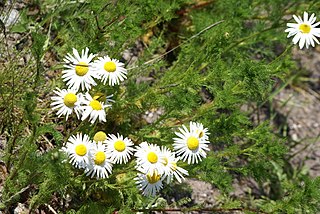
Chamomile or camomile is the common name for several daisy-like plants of the family Asteraceae. Two of the species, Matricaria chamomilla and Chamaemelum nobile, are commonly used to make herbal infusions for beverages. There is insufficient scientific evidence that consuming chamomile in foods or beverages has any beneficial effects on health, although in Hungarian they refer to it as king of herbs 'orvosi székfű'.

Matricaria discoidea, commonly known as pineappleweed, wild chamomile, disc mayweed, and rayless mayweed, is an annual plant native to northeast Asia where it grows as a common herb of fields, gardens, and roadsides. It is in the family Asteraceae. The flowers exude a chamomile/pineapple aroma when crushed. They are edible and have been used in salads and to make herbal tea.

Xanthium (cocklebur) is a genus of flowering plants in the tribe Heliantheae within the family Asteraceae, native to the Americas and eastern Asia and some parts of south Asia.

Matricaria chamomilla, commonly known as chamomile, German chamomile, Hungarian chamomile (kamilla), wild chamomile, blue chamomile, or scented mayweed, is an annual plant of the composite family Asteraceae. Commonly, the name M. recutita is applied to the most popular source of the herbal product chamomile, although other species are also used as chamomile. Chamomile is known mostly for its use against gastrointestinal problems; additionally, it can be used to treat irritation of the skin.

Cyperus is a large genus of about 700 species of sedges, distributed throughout all continents in both tropical and temperate regions.

Bidens frondosa is a North American species of flowering plant in the aster family, Asteraceae. It is widespread across much of Canada, the United States, and Mexico It is known in many other parts of the world as an introduced species, including Europe, Asia, Morocco, and New Zealand. Its many common names include devil's beggarticks, devil's-pitchfork, devil's bootjack, sticktights, bur marigold, pitchfork weed, tickseed sunflower, leafy beggarticks, and common beggar-ticks.

Clethra is a genus of flowering shrubs or small trees described as a genus by Linnaeus in 1753.

Tripleurospermum inodorum, common names scentless false mayweed, scentless mayweed, scentless chamomile, and Baldr's brow, is the type species of Tripleurospermum. This plant is native to Eurasia and North Africa, and introduced to North America, where it is commonly found in fields, fallow land and gardens.

Anthemis cotula, also known as stinking chamomile, or mayweed, is a flowering annual plant with a noticeable and strong odor. The odor is often considered unpleasant, and it is from this that it gains the common epithet "stinking". In pre-colonial times, its distribution was limited to the Old Continent and Africa; though it was established in most of Europe, it was not present in Finland, Ireland, or the northernmost reaches of Scotland, in spite of the fact that these countries feature climatic regions favorable to this plant and are in proximity to countries where the species is native, such as Russia, Estonia, Lithuania and England. It has successfully migrated to the American continents where it can be found growing in meadows, alongside roads, and in fields.

Erigeron acer is a widespread herbaceous flowering plant in the family Asteraceae. Common names include bitter fleabane and blue fleabane. The species is native to Canada, colder parts of the United States, northern, central, and southeastern Asia, and most of Europe.

Tripleurospermum is a genus in the chamomile tribe within the sunflower family. Mayweed is a common name for plants in this genus.

Coreopsis bigelovii is a species of flowering plant in the daisy or sunflower family, Asteraceae, with the common names Bigelow coreopsis and Bigelow's tickseed. It is endemic to California.

Tripleurospermum maritimum is a species of flowering plant in the aster family commonly known as false mayweed or sea mayweed. It is found in many coastal areas of Northern Europe, including Scandinavia and Iceland, often growing in sand or amongst beach pebbles.

Bidens cernua is a species of flowering plant in the aster family, Asteraceae. Bidens cernua is distributed throughout much of Eurasia and North America. It is commonly called nodding beggarticks or nodding bur-marigold.

Chrysogonum is a genus of flowering plants in the family Asteraceae found only in eastern North America. Confusion regarding species that were named in Chrysogonum from other parts of the world, such as Madagascar, was clarified by Stuessy who reduced the genus to having only a single species with two varieties. A similar treatment was proposed by Nesom, although in that treatment 3 varieties were accepted. The plants are low-growing terrestrial herbs with yellow flower heads containing both disc florets and ray florets. The genus is distinctive in having pistillate ray florets and staminate disk florets, and the pistil of the ray floret is fused to the adjacent phyllary as well as 3 paleae and their associated disk florets to form a "cypsela complex". The species is grown as an ornamental plant under the common name of Green and Gold, and is used primarily as a ground cover.

Achillea alpina, commonly known as alpine yarrow, Chinese yarrow or Siberian yarrow, is an Asian and North American species of plant in the sunflower family. It is native to Siberia, the Russian Far East, China, Mongolia, Korea, Japan, Nepal, Canada, the northern United States.

Bidens bipinnata is a common and widespread species of flowering plant in the family Asteraceae.

Crepis bursifolia, commonly known as Italian hawksbeard, is a species of flowering plant in the family Asteraceae. It is native to southern Europe, as well as being sparingly naturalized in California.
Matricaria occidentalis, commonly known as valley mayweed, is an annual plant native to North America. It is in the family Asteraceae.

Oncosiphon pilulifer, also known as globe chamomile and stinknet, is a flowering plant in the daisy family (Asteraceae) native to South Africa and Lesotho. It is considered invasive in some parts of North America.





















